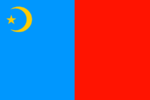Hasanis

|
This article or section is a work in progress. The information below may be incomplete, outdated, or subject to change. |
 Flag of the Hasani people, as well as the Hasanistani separatist movement | |
| Total population | |
|---|---|
| 809,501 (2017 census)-1,300,000 | |
| Regions with significant populations | |
| Balkanshahr (Hasanistan, Kurjek District), Kuregred Metropolitan Area, Nuví Pelezu | |
| Languages | |
| Hasani, Šlovedk | |
| Religion | |
| Virtually all are Sunni Muslim, irreligious minority in urban areas | |
| Related ethnic groups | |
| Coriaks |
Hasanis are a Turkic Sunni Muslim ethnic group very similar to Turks, mainly inhabiting the region of Hasanistan, Balkanshahr in Krasnarus, living in isolated villages in mountains and in valleys. Hasanis, unlike their neighboring groups in Balkanshahr, are very well-organized, having 16 newspapers, 14 other Hasani-language online news outlets, and 30 officially registered cultural, college scholarship, political and nationalist-separatist organizations in total.
History
The origins of Hasanis are unknown, but they are reputed to be the original inhabitants of Balkanshahr. However, it is unclear if they truly predate the Anticans and previous groups in the region. Most scholars agree that the claim is probably purely a myth.
Afterwards, a few Hasanis who could escape said valleys and other hard-to-pass areas did so. They began to move to larger coastal cities, particularly Kuregred and Nuví Pelezu, where they established a respected, business-owning middle class - which has been able to provide very handsome funds for the development of the Hasanistan region back home, and other areas of Balkanshahr as well. However, even though Hasanis are well-established, Šlovedk and Corian fans are known to throw kebabs at Hasanis at football matches, and Corian and Šlovedk gangs in urban areas are known to ransack and occasionally destroy Hasani businesses. Hasanis are the only ethnic group in the city, however, to receive police protection and aid in recent years, which is making it more difficult for the gangs to target Hasanis.
The territory was in anarchy until Krasnarus formally made its claim to Micras in 2017, which included Albion and Sylvania. During this period, the government went into Hasani-majority areas, restoring order and conducting the census.
There is also a large, mostly peaceful movement for the independence of Hasanistan from Krasnarus, which would be intended to serve as a homeland for Hasanis and displaced Muslim Jingdaoese and Coriak diaspora in the region as well. It is advocated by a significant number of Hasani intellectuals. Professor Ümit Çakar of the of the University of Šer-ku-Riž, who was one of Hasanistan District's more controversial leaders, is the most notable advocates of the movement. It has an estimated 11,000 supporters.
Census
As of 2017, out of 334,242 self-identified Hasanis, 54.9% of them male and 45.1% were female. 31.1% were living in poverty, and their average income was Cr13,450. 93.86% had employment, and 21.7% of individuals over age 26 had college degrees - one of the highest college graduation rates for any group in the country. Also, only 9,512 individuals of Hasani descent were on the Registry of Individuals Convicted of Felony Offenses (RFUUZTČ).
Politics
Notable people
- Ümit Çakar, Professor of Sociology at University of Šer-ku-Riž and chairman of the Hasani National Council
Areas with significant populations
Krasnarus
- Silvensku (566,031)
- Elbijun (228,800)
- Phedodah (14,670)